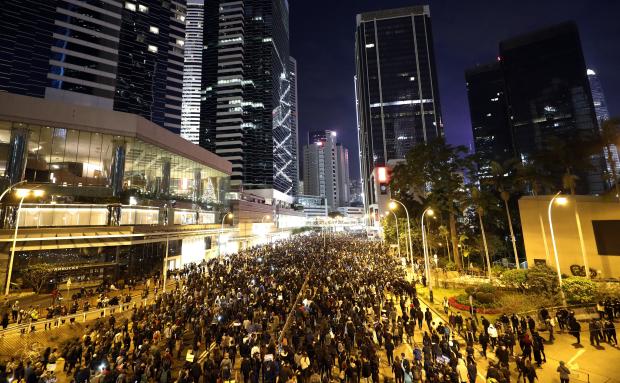
Pro-democracy protesters take part in a march on a street in Hong Kong, Sunday, Dec. 8, 2019. Thousands of people took to the streets of Hong Kong on Sunday in a march seen as a test of the enduring appeal of an anti-government movement about to mark a half year of demonstrations. (Photo by Vincent Thian / AP)
HONG KONG — Hundreds of thousands of demonstrators crammed into Hong Kong’s streets on Sunday, their chants echoing off high-rises, in a mass show of support for a protest movement that shows no signs of flagging as it enters its seventh month.
Chanting “Fight for freedom” and “Stand with Hong Kong,” a sea of protesters formed a huge human snake winding for blocks on Hong Kong Island, from the Causeway Bay shopping district to the Central business zone, a distance of more than 2 kilometers (1 1/4 miles).
The crowds were so large and dense that the march ground to a standstill at times. Protesters spilled into narrow side streets, crying “Revolution in our times.” One protester crawled part of the route prostrated on her hands and knees, dragging bricks and empty soda cans behind her. It was an apt metaphor for the pro-democracy movement, which has become a long-haul push to preserve Hong Kong’s freedoms that make it unique among China’s cities.
“This is just the beginning. We have a long way to run,” said another demonstrator, Louisa Yiu, an engineer.
Many marchers held up five fingers to press the movement’s five demands. They include democratic elections for Hong Kong’s leader and legislature and a demand for a probe of police behavior during the six months of continuous protests.
Marchers said they hoped the huge turnout might help win concessions from the government of Chief Executive Carrie Lam. Protesters spanned generations. One man’s young son marched in his Spiderman suit.
“So many people are still supporting this movement. You can see how determined Hong Kong people are,” said demonstrator Justin Ng, a 20-year-old student.
“I heard a small kid yelling slogans — 4, 5 years old,” Ng said. “That really encouraged me because it’s not just this generation but future generations, too.”
Marchers said protesting has become part of the fabric of their lives since demonstrations erupted in June against a now-withdrawn government measure that would have allowed criminal suspects to be sent for trial in Communist Party-controlled courts in mainland China.
The protests have since snowballed into a broad, sustained anti-government movement, presenting the communist leadership in Beijing with a major headache and battering Hong Kong’s economy.
Police in riot gear deployed in numbers on the edges of the march. Earlier in the day, they arrested 11 people and seized a cache of weapons, including a firearm with more than 100 bullets. Police said the suspects apparently planned to use the weapons during the protest to frame police, who have been accused of using excessive force against the protesters.
Rally organizer Eric Lai called for police restraint and for no use of tear gas.
“We hope this will be a signature for our movement after six months to show to Carrie Lam as well as to the world that people are not giving up. People will still fight for our freedom and democracy,” Lai said.
Authorities, who have liberally used tear gas, water cannons and rubber bullets at previous demonstrations, say force has been necessary to disperse hard-core protesters who have battled riot officers, vandalized shops and thrown gasoline bombs.
Police banned mass marches as protests turned increasingly violent, but relented and allowed Sunday’s march after a few weeks of relative peace.
The rally was called by the Civil Human Rights Front, a group that has organized some of the biggest demonstrations since hundreds of thousands of protesters first marched on June 9 against the extradition bill.
Chief among the protesters’ complaints Sunday was that police have been overly heavy-handed, making thousands of arrests since June.
“They are out of control,” said Ernest Yau, a 28-year-old consultant. He said the movement has brought Hong Kong together.
“We understand our common enemy,” he said. “We understand that we have to be united to fight against China, to fight against a government that doesn’t listen to its people.”
/atm